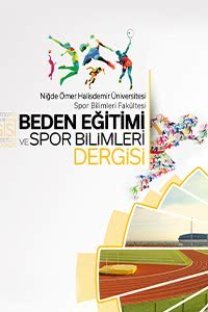Effect of pliometric training on anaerobic performance in young basketball players
Genç basketbolcularda pliyometrik antrenmanın anaerobik performans değerlerine etkisi
___
- 1. Bompa TO. Power Training For Sport: Plyometrics for Maximum Power Development. New Revised Edition, Coaching Association of Canada, 1996
- 2. Hoffman J. Physiological Aspects of Sport Training and Performance. USA: Human Kinetics, 2002.
- 3. Komi PV. Strength and Power in Sport. London: Blackwell Scientific Publications, 1992.
- 4. Chu DA. Jumping Into Plyometrics. 2nd Ed., USA: Human Kinetics, 1998.
- 5. Howard RL. Plyometric concept reinvent lower extremity rehabilitation. Biomechanics, 2004; September, s: 63–67.
- 6. Baechle TR and Earle RW. Essentials of Strength Training and Conditioning. China: Human Kinetics, 2000.
- 7. Wilkens L. National Basketball Conditioning Coaches Association. NBA Power Conditioning. USA: Human Kinetics, 1997, ISBN: 0-88011-687-0.
- 8. Sevim Y. Physical Fitness Training in Basketball [Basketbolda Kondisyon Antrenmanı]. 1st Edition. Ankara: Nobel Basımevi, 2003
- 9. Dündar U. Physical Fitness in Basketball [Basketbolda Kondisyon]. İkinci Baskı. Ankara: Nobel Basımevi, 2004.
- 10. Wilkens L. 14 Leading Strenght and Conditioning Coaches of the NBA. Condition The NBA Way. New York: Cadell & Davies, 1994, ISBN: 1-56977-886-8
- 11. Kibele A. Possible errors in the comparative evaluation of drop jumps from different heights. Ergonomics, 1999; Jul; volume 42, issue 7.
- 12. Tricoli V, Lamas L, Carnevale R, Ugrinowitsh C. Short-Term Effects On Lower-Body Functional Power Development: Weightlifting vs. Vertical Jump Training Programs. J Strength Cond Res, 2005; May; 19(2): 433-7.
- 13. Diallo O, Dore E, Duche P, Van Praagh E. Effect of plyometric training followed by a reduced training programme on physical performance in prepubescent soccer players. J Sports Med Phys Fitness, 2001; Sep;41(3): 342-8.
- 14. Matavulj D, Kukolj M, Ugarkovic D, Tihanyi J, Jaric S. Effects of plyometric training on jumping performance in junior basketball players. J Sport Med Phys Fitness, 2001; Jun; 41(2):159-64.
- 15. Tanita Corporation. Illinois, USA. Tanita BF-555, BF-556 Body Fat Monitor Instruction Manuel.
- 16. Duda, M. Plyometrics. A Legitimate Form of Power Training. The Physician and Sport Medicine. 1988; 16: 213-218
- 17. Gür E. The effect of specially designed pliometric training on anaerobic power performance in young football players. [Özel düzenlenmiş pliyometrik antrenmanların genç futbolcuların anaerobik güç performanslarına etkisi]. Fırat Üniversitesi – Yüksek Lisans Tezi, 2001
- 18. Döğüşçü M. Effect of Combined Strenght Training and Plyometric Traning Programmes on Vertical Jumping in Women Voleyball Players [Bayan voleybolcularda kombine kuvvet antrenmanı ile pliyometrik antrenman programlarının dikey sıçrama kuvvetine etkisi]. Gazi Üniversitesi – Doktora Tezi, 1999
- ISSN: 1307-6477
- Yayın Aralığı: Yılda 3 Sayı
- Başlangıç: 2007
- Yayıncı: Niğde Üniversitesi Beden Eğitimi ve Spor Yüksek Okulu
Comparison of self-esteem scores of individual and team sport athletes and non- athletes
AZİZ GÜÇLÜÖVER, ERKAN DEMİRKAN, Mehmet KUTLU, ALİ ERDEM CİĞERCİ, Hüseyin Tolga ESEN
Rekreasyonel spor hizmetleri kalite ölçeği- 38’in Türkçe versiyonu geçerlik ve güvenirlik çalışması
Emine DEMIR KÖŞKER, Zafer ÇİMEN
Selçuk GENCAY, YAĞMUR AKKOYUNLU
Determining the motivation level of the 25th winter Universiade human resources
M.Alparslan KURUDİREK, Emre BELL, DURSUN KATKAT, ADEM TÜZEMEN
The comparison of balance and body fat percentage of elite futsal players and sedentary people
Alper Cenk GÜRKAN, OZAN SEVER, Fatma Nur ER, CEREN SUVEREN ERDOĞAN, MEHMET KOÇAK, MUHSİN HAZAR
Ozan BOZKURT, ZİYA KORUÇ, Nihan ARSLAN, Serdar KOCAEKŞİ
OĞUZ TÜRKAY, SEYİT AHMET SOLMAZ, ABDULMENAF KORKUTATA, ÇAĞRI ERDOĞAN
ALİ SERDAR YÜCEL, YUNUS EMRE KARAKAYA, BİLAL ÇOBAN, Cemal GÜNDOĞDU, ÖZGÜR KARATAŞ
RAMİZ ARABACI, Salih ERDEN, Nimet KORKMAZ HAŞIL, Cemali ÇANKAYA, Faruk KORKMAZ
